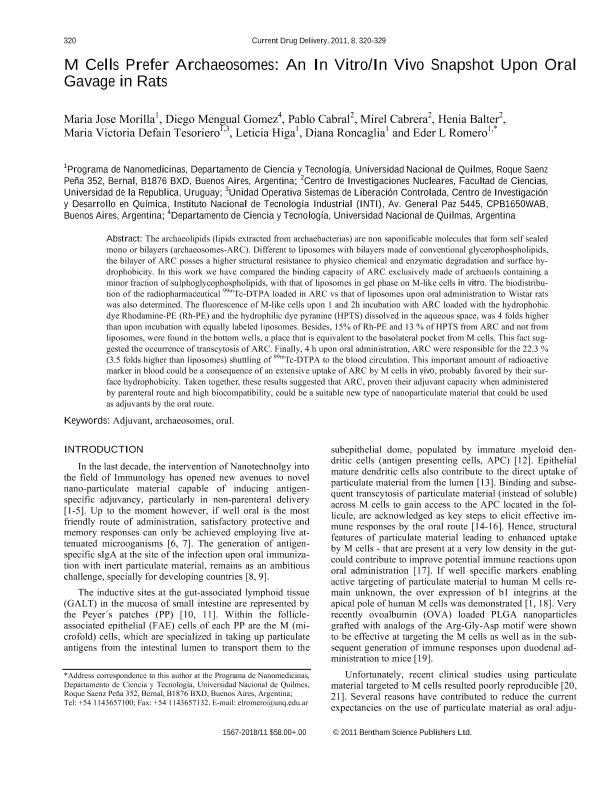Artículo
M cells prefer archaeosomes: An in vitro/in vivo snapshot upon oral gavage in rats
Morilla, María José ; Mengual Gómez, Diego Luis
; Mengual Gómez, Diego Luis ; Cabral, Pablo; Cabrera, Mirel; Balter, Henia; Defain Tesoriero, María Victoria; Higa, Leticia Herminia
; Cabral, Pablo; Cabrera, Mirel; Balter, Henia; Defain Tesoriero, María Victoria; Higa, Leticia Herminia ; Roncaglia, Diana Inés; Romero, Eder Lilia
; Roncaglia, Diana Inés; Romero, Eder Lilia
 ; Mengual Gómez, Diego Luis
; Mengual Gómez, Diego Luis ; Cabral, Pablo; Cabrera, Mirel; Balter, Henia; Defain Tesoriero, María Victoria; Higa, Leticia Herminia
; Cabral, Pablo; Cabrera, Mirel; Balter, Henia; Defain Tesoriero, María Victoria; Higa, Leticia Herminia ; Roncaglia, Diana Inés; Romero, Eder Lilia
; Roncaglia, Diana Inés; Romero, Eder Lilia
Fecha de publicación:
01/2011
Editorial:
Bentham Science Publishers
Revista:
Current Drug Delivery
ISSN:
1567-2018
Idioma:
Inglés
Tipo de recurso:
Artículo publicado
Clasificación temática:
Resumen
The archaeolipids (lipids extracted from archaebacterias) are non saponificable molecules that form self sealed mono or bilayers (archaeosomes-ARC). Different to liposomes with bilayers made of conventional glycerophospholipids, the bilayer of ARC posses a higher structural resistance to physico chemical and enzymatic degradation and surface hydrophobicity. In this work we have compared the binding capacity of ARC exclusively made of archaeols containing a minor fraction of sulphoglycophospholipids, with that of liposomes in gel phase on M-like cells in vitro. The biodistribution of the radiopharmaceutical 99mTc-DTPA loaded in ARC vs that of liposomes upon oral administration to Wistar rats was also determined. The fluorescence of M-like cells upon 1 and 2h incubation with ARC loaded with the hydrophobic dye Rhodamine-PE (Rh-PE) and the hydrophilic dye pyranine (HPTS) dissolved in the aqueous space, was 4 folds higher than upon incubation with equally labeled liposomes. Besides, 15% of Rh-PE and 13 % of HPTS from ARC and not from liposomes, were found in the bottom wells, a place that is equivalent to the basolateral pocket from M cells. This fact suggested the occurrence of transcytosis of ARC. Finally, 4 h upon oral administration, ARC were responsible for the 22.3 % (3.5 folds higher than liposomes) shuttling of 99mTc-DTPA to the blood circulation. This important amount of radioactive marker in blood could be a consequence of an extensive uptake of ARC by M cells in vivo, probably favored by their surface hydrophobicity. Taken together, these results suggested that ARC, proven their adjuvant capacity when administered by parenteral route and high biocompatibility, could be a suitable new type of nanoparticulate material that could be used as adjuvants by the oral route.
Palabras clave:
ADJUVANT
,
ARCHAEOSOMES
,
ORAL
Archivos asociados
Licencia
Identificadores
Colecciones
Articulos(SEDE CENTRAL)
Articulos de SEDE CENTRAL
Articulos de SEDE CENTRAL
Citación
Morilla, María José; Mengual Gómez, Diego Luis; Cabral, Pablo; Cabrera, Mirel; Balter, Henia; et al.; M cells prefer archaeosomes: An in vitro/in vivo snapshot upon oral gavage in rats; Bentham Science Publishers; Current Drug Delivery; 8; 3; 1-2011; 320-329
Compartir
Altmétricas



